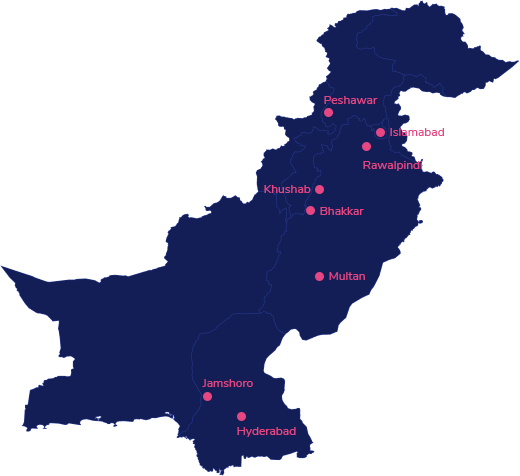Women and girls have a labour force participation rate of 24.6%; men and boys have a rate of 80.9%. Women and girls are also more likely to be in vulnerable employment (69.3%) than men and boys (50.5%), though this rate has been decreasing over time (The World Bank, Pakistan). Of the women and girls in the labour force, 67.9% work in the agricultural sector, compared to 28.7% of men and boys.

The age at first marriage is gradually increasing, with the average age of marriage now 23.7 for women and girls and 26.9 for men and boys. However, as of 2018, 18% of women and girls were first married by age 18 (The World Bank, Women Who Were First Married by Age 18).
Major gains have been made in Pakistan towards education parity for women and girls and men and boys: 65% of girls and 67% of boys are completing primary school. However, universal primary and secondary education has not yet been achieved, with a 39% completion rate for junior secondary and 31% completion rate for senior secondary for women and girls, and completion rates of 38% and 28%, respectively, for men and boys. Gaps in education attainment are widest in rural and poor areas, where women and girls are pressured to drop out of school for a variety of reasons (UNICEF, Pakistan Education Fact Sheet).
Pakistan experiences climate change and climate-related disasters that are putting pressure on vulnerable communities — for example, extreme changes in annual maximum and minimum temperatures, droughts, epidemics and floods that contribute to illness and insecurity (The World Bank, Climate Change Country Profile Pakistan).
Extreme temperatures are a particularly noticeable effect of climate change in Pakistan. It is now not unusual for many areas to experience temperatures of 38°C and prolonged heatwaves. It is estimated that Pakistan experienced 126 heatwaves between 1997 and 2015 — an average of almost seven per year — and the incidence continues to increase (The World Bank, Climate Change Knowledge Portal Vulnerability). Heatwaves and extreme temperatures have impacts on the health and wellness of humans. There is also an economic impact: days of extreme heat reduce workers’ ability to work safely, putting a strain on production and hourly earnings.
Flooding also occurs in many regions of Pakistan, badly impacting the lives of women and girls. In 2010, for example, floods affected the lives of 713,000 women and girls aged between 15 and 49 and 133,000 pregnant women. Many girls were unable to attend school, with 50% of girls enrolled in school in flood-affected districts (Mumtaz, Women and Climate Change). Access to healthcare, particularly neonatal and emergency obstetric care, was disrupted, as was access to sanitation facilities and latrines, which reduced the physical and psychological safety of women and girls. Furthermore, approximately 640,000 girls in flood-affected areas are at increased risk of coercion, gender-based violence and child marriage (The World Bank, Climate Change Country Profile Pakistan).
Women and girls are vulnerable to the effects of climate change events because of their lack of social and economic empowerment. Women/girlsThey often lack access to mobile phones or early warning systems (UNDP, Gender Equality in Pakistan), and they are not involved in decision-making about issues related to climate change, so programmes and interventions do not take their specific needs into account.
An estimated 27 million people in Pakistan are living with disabilities. Of those, 70% are women and girls living in rural areas (UNPRPD, Moving from Charity model to Rights based work). Commonly experienced disabilities are physical, hearing, visual and mental impairments (NADRA, Cumulative Disability Data).
Persons with disabilities are very vulnerable, and they often face physical and social barriers in accessing education, employment and services. For example, they face barriers in accessing school, employment and their legal rights. Children with disabilities have lower education participation rates than the general population. Approximately 41.4% of school-aged children have physical disabilities, 12.1% have behavioural disabilities and 11.8% have multiple disabilities (The Economist, Mainstreaming persons with disabilities in Pakistan). There are gaps in public education services that offer special education opportunities. As well, classroom accessibility is a challenge: only 2% of schools have ramps and only 5% have disability-friendly washrooms (UNICEF, Disability-Inclusive Education Practices in Pakistan).
Persons with disabilities face barriers to attending vocational training and finding employment. The barriers include inadequate accessibility of transport to get to work, lack of workplaces and jobs that support a range of disabilities and cultural stigma. There is a strong cultural stigma in Pakistan around disabilities, with many families seeking to hide or deny disabilities in their children. This can make it difficult to identify and support people with disabilities. Culturally, women and girls with disabilities face a particular stigma relating to their potential as life partners: it is considered harder for them to marry compared to men and boys with disabilities (The Economist, Mainstreaming persons with disabilities in Pakistan). Women and girls with disabilities are more vulnerable to domestic violence, and since their abusers are often also their caretakers, they face extra barriers when seeking security (UN Women, Pakistan: Multiple threats to women/girls living with disabilities during Covid-19).
Access to healthcare is another area of concern for persons with disabilities. Many persons with disabilities live in rural areas, where healthcare services are often limited or inadequate. There is limited state-funded care for long-term disabilities, which creates financial challenges for those who need care. Where healthcare services do exist, they are not all accessible to people whose mobility is impaired (The Economist, Mainstreaming persons with disabilities in Pakistan).